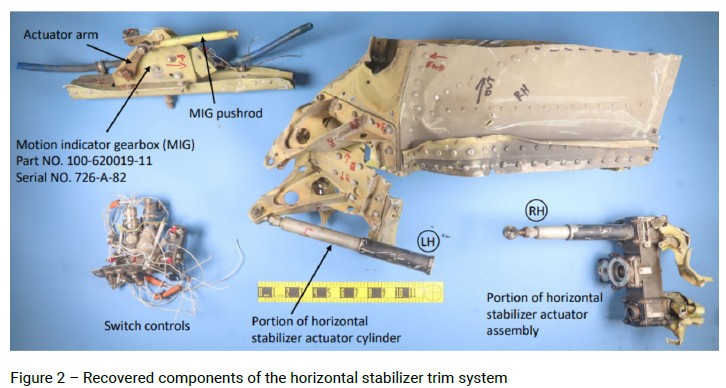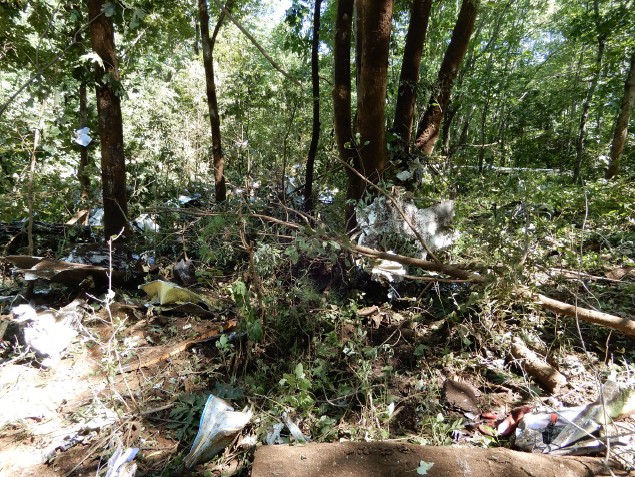
Federal investigators have determined the cause of a 2023 plane crash in Litchfield that killed two pilots.
An anomaly with the Beech C-99 aircraft’s horizontal stabilizer system was most likely to blame, according to a final investigation report that the National Transportation Safety Board released last month. But the report makes no clear conclusion about why exactly the stabilizer malfunctioned.
The 11-page report and several related documents and animations, posted online Sept. 11, were the result of a two-year long investigation into the Aug. 22, 2023, crash.
The crash killed pilots James Shepard-Kegl, 69, of North Yarmouth, and Jumaane Omari Stanley Melville, 37, of St. Petersburg, Florida, officials said previously.
The two were operating the twin-engine turboprop aircraft, manufactured in 1982, for a Wiggins Airways training flight.
The airplane had a “dual electric horizontal stabilizer trim system,” driven by two cylinder rods. A horizontal stabilizer is a horizontal surface — smaller than a wing — attached to the tail of a plane that helps control its movements.
Investigators examining the wreckage found the right-hand cylinder rod end disconnected before the crash, as the connecting bolt, nut and washers were missing.
That hardware also connected the rod to a gearbox system that provided pilots with information in the cockpit about stabilizer movement and takeoff trim position, investigators wrote. If disconnected, that information would have been missing or incorrect.
Either cylinder rod was capable of operating the stabilizer, but the manufacturer, Beechcraft, considered operation with one cylinder rod to be “limited emergency operation” mode, according to the report.
“The investigation was not able to determine the effects of the pitch trim operating with only one cylinder rod attached for an undetermined but possibly extended duration,” the report concluded. “Functional testing of the components was not possible due to impact damage.”
A review of the plane’s records did not show any recent maintenance on the horizontal stabilizer actuator or its fastening hardware, the report states.
As part of the investigation, NTSB investigators ruled out a reported “near-miss” minutes before the crash as related to its cause. A pilot and flight instructor flying in the area said they saw the aircraft make an abrupt right turn, and they also turned to avoid crashing into it.
It was the only time during their flight that the two would see the aircraft that ultimately crashed, they wrote in witness statements.
The report details what seemed to be a mostly normal flight up until its final moments.
Shepard-Kegl, in the right seat of the cockpit, was an experienced flight instructor. He had an estimated 14,700 hours of flying experience, 1,342 of those in the Beech C-99, the NTSB reported.
Wiggins Airways’ chief pilot, Steve Parsons, wrote in a statement to NTSB investigators that Shepard-Kegl was safety conscious, always looking for safer ways to do things. He mentored other pilots and helped develop a new checklist for the Beech C-99, Parsons wrote.

Melville, in the left seat, was a recently hired pilot on his third commercial training flight for the cargo carrier. He had an estimated 1,302 hours of flight time, with 4 hours in the Beech C-99.
The two, who are not named in the final report, took off from Auburn/Lewiston Municipal Airport at 5:08 p.m. the day of the crash, according to the report. The flight proceeded to the southwest, and the pilots, returning to the airport, performed a missed approach, continuing to the northeast.
The flight then entered a holding pattern at about 3,000 feet, the report states.
“While completing the first turn of the holding pattern, the airplane entered a steep descent and subsequently impacted terrain” around 5:40 p.m., investigators wrote.
The plane crashed in a densely wooded area off Oak Hill Road. Data showed the plane was in a nose-down attitude more than 20 degrees, a slight right bank, and at an airspeed exceeding 250 knots. There were no distress calls or communications with air traffic control; at the time of the crash, the pilots were not required to be communicating with controllers, the report says.
The plane first struck 50-foot-tall oak trees, then impacted soft soil 140 feet east.

The wreckage was “heavily fragmented” and spread over an area 424 feet long and 100 feet wide, the report says. There was no fire. The engines, propeller assemblies, landing gear and other parts had separated, but investigators found all structural components in the debris field.
The wreckage was transported to AMF Aviation LLC’s facility in Southwick, Massachusetts, where investigators examined it in detail, records show.
At least one person witnessed the crash. Andy Wilding, one of the people who called 911 to report the crash, told investigators he saw the plane suddenly in a steep dive toward Oak Hill.
“At first when it disappeared behind the trees on Oak Hill I wondered if maybe it had gone behind the hill and would reappear shortly,” Wilding said. “Instead after a few seconds I heard a loud boom. I stood there in shock staring at Oak Hill not wanting to believe what I just saw.”
Another witness, David Walko, said he watched the plane for about 15 seconds and it appeared to be flying normally. When Walko looked away to start a tractor, he heard a loud bang, a similar account he provided to the Kennebec Journal at the time.
Wiggins Airways, based in Manchester, New Hampshire, has been in operation for nearly a century, according to its website.
Ameriflight has owned the carrier since 2014. A spokesperson for the company with headquarters in Dallas did not respond to an email Thursday afternoon seeking comment about the final investigative report.
